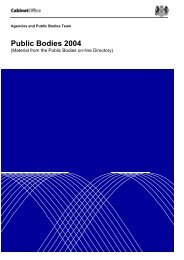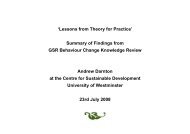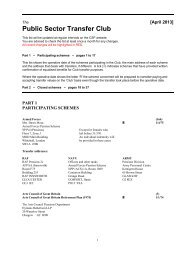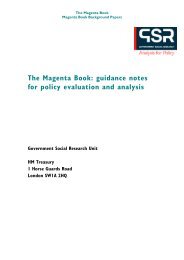Land Registry <strong>Cultural</strong> <strong>Diversity</strong>Hindi is the most widely understood Indic language in Britain as well as in thesubcontinent, partly because of its official status but also because it is the commonlanguage of “Bollywood” – the extremely successful Indian film and musical industry.UrduUrdu is the mother tongue of around 5 million Pakistanis and 30 million Indians. Inaddition, some 60 million people speak it as a second language, largely because of itsassociation with the Muslim faith. It is also the official language of Pakistan, and ofsome regions in India.As a spoken language it is almost identical to Hindi, having a common source in theold Hindustani dialect, the obvious distinction being that it uses a different script – thePerso-Arabic script, which reads from right to left. When India was partitioned andPakistan was established as a separate nation in 1947, the distinction between thetwo forms of the dialect became a matter of constitution, at which point, the idea of aHindustani dialect fell into disuse.Urdu, as the language of subcontinental Muslims, is heavily influenced by Arabic, andmany Arabic, Persian and even Turkish words have come into the language, replacingthe old Sanskrit ones that remain in Hindi.BengaliBengali is the national language of Bangladesh, and is spoken by almost all thepopulation (some 100 million). It is also spoken by around 60 million people living inthe old state of Bengal in north eastern India. Bangladeshi speakers tend to beMuslims while Indian speakers tend to be Hindus, and this may occasionally give riseto variances in the way the language is used.<strong>The</strong> cultural life of Bengal has produced at least one globally known figure in the arts –the Bengali writer Rabindranath Tagore (1861-1941) who won the Nobel Prize forliterature in 1913.GujaratiThis is the language of the state of Gujarat, which is situated in the extreme northwest of India, bordering Pakistan and the Arabian Sea. Here there are around 35million Gujarati speakers. Another language which developed out of Sanskrit, it alsohas its own script, which is similar to that of Hindi and Bengali but without the barrunning across the top of each character.Significant numbers of UK Gujarati-speakers have come from East Africa, rather thanIndia. Whole families emigrated to Kenya and Uganda in the 1950s only to findthemselves deported in the 1970s, during the “Africanisation” programmes brought inby the governments of those countries.32
Land Registry <strong>Cultural</strong> <strong>Diversity</strong>PunjabiPunjabi is spoken in the historic state of the Punjab which was split between India andPakistan after partition. <strong>The</strong>re are some 60 million speakers in Pakistan and 15 millionin India. As a result of its geographic position, there are a number of influences on thespoken language, the eastern parts of the province favouring a Hindi influence, with agrowing Urdu influence the further west one moves. <strong>The</strong> written language can useeither a Perso-Arabic script or a Sanskrit-influenced Gurmukhi script, the latter beingthe more commonly used amongst Punjabi speakers in Britain.Punjabi has traditionally been identified with the Sikh religion. <strong>The</strong>re are, however,many Muslims and Hindus who also speak Punjabi.Although it can be useful to split UK subcontinentals into five language speaking groups,the situation is not as simple as this might imply. Most people have an understanding ofmore than one language and consequently the process of cross-fertilisation between thelanguages is particularly rich. <strong>The</strong>re are many unofficial borrowings form one language toanother, of words and even of scripts. A person who can speak Urdu but who is unableto write it, for example, will very often simply write his message using the Hindi script!<strong>The</strong> influence of local dialect can complicate matters further; there are, for example, anumber of different dialects of Gujarati and it can be difficult when translating tochoose the most appropriate language for UK Gujarati speakers. <strong>The</strong> dialect spokenin the Sylhet region of Bangladesh is so distinct that there is a movement to regard itas a separate language, though as yet it has no written script. In Pakistan the Lahndadialect of Punjabi is in a similar situation.<strong>The</strong> impressive degree of multilingualism amongst these communities is a little moreunderstandable, once it is realised that all five languages are from the same linguisticfamily – the Indic languages, which are a branch of the Indo-European group fromwhich most European languages are derived. Consequently, many common or similarwords occur in all five languages.While many words have a root common to each language, many of them are alsostrikingly similar to English or European words. Also, not surprisingly, a growing numberof English words have become part of the language used by Indic communities inBritain. Words relating to aspects of British life and culture, for which the terms whichexist in the language do not quite capture the context – “bus”, “nurse”, “fax” forexample – are common coinage amongst the Indic language speakers in this country.Finally, there are words of Indic origin which were assimilated into the Englishlanguage long before the arrival of the first immigrants to the UK from thesubcontinent – words such as catamaran, bazaar, caravan, khaki, cot, loot, thug,dungaree, pundit, juggernaut. <strong>The</strong> process of cross-fertilisation between languages isa long-standing and ongoing one, one that enriches cultures and contributes to thechanging nature of language itself.33

















